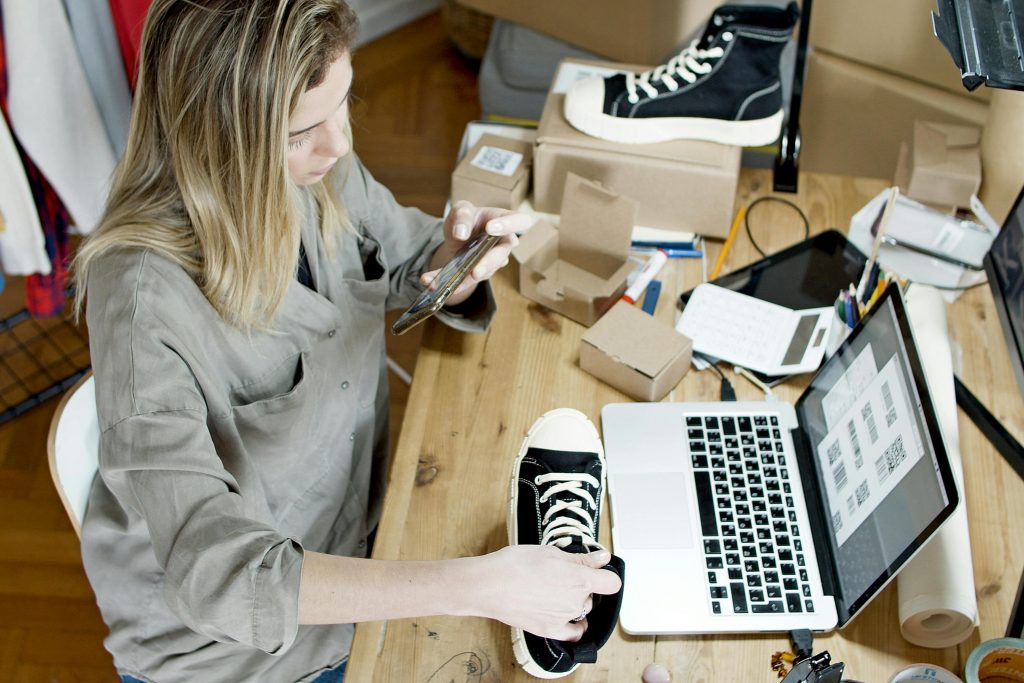Reselling has become one of the most accessible ways to earn extra income. Whether you want to turn clutter into cash, start a side hustle, or eventually build a full-time business, learning how to start reselling and make your first sale fast is the best way to get momentum.
The good news? You don’t need a big investment or advanced skills to get started. What you do need is a clear strategy, a little time, and the willingness to experiment. In this guide, we’ll break down everything step by step so you can begin reselling confidently and see results quickly.
What Does Reselling Actually Mean?
At its core, reselling means buying products and then selling them at a higher price for profit. You could be reselling items you already own, wholesale goods, clearance finds, or even rare collectibles.
Common reselling models include:
- Thrift Reselling – Finding items at thrift stores, yard sales, or flea markets and flipping them online.
- Retail Arbitrage – Buying discounted items at retail stores (like Walmart or Target) and reselling them online for a higher price.
- Online Arbitrage – Similar to retail arbitrage, but you source discounted products from e-commerce websites.
- Wholesale Reselling – Purchasing items in bulk directly from suppliers and reselling individually.
- Private Label Reselling – Rebranding products from manufacturers and selling under your own brand.
For beginners who want fast results, thrift reselling, retail arbitrage, or simply selling things from around the house are often the best starting points.
Why Start Reselling Now?

You might be wondering, why is reselling such a popular side hustle right now? Here are some reasons:
- Low barrier to entry – You can start with as little as $20 by selling things you already own.
- Flexible schedule – You can work at your own pace and scale up when you’re ready.
- Fast learning curve – Unlike other businesses, reselling allows you to learn as you go without huge upfront risks.
- Growing online marketplaces – Platforms like eBay, Amazon, Poshmark, and Facebook Marketplace make it easier than ever to reach buyers.
If you want to make money quickly, reselling is one of the fastest business models to test out.
How to Start Reselling: The First Steps
Getting started doesn’t have to feel overwhelming. Instead of trying to do everything at once, break it down into clear steps you can follow right away.
1. Decide What You’ll Sell
The fastest way to make your first sale is to start with what you already own. You don’t need to invest in new inventory right away—your home is likely full of things that other people want.
Look around for:
- Clothing you no longer wear – Branded clothing, shoes, and accessories tend to resell well, especially in good condition. Think of items like Levi’s jeans, Nike sneakers, or Coach handbags.
- Electronics you’ve upgraded from – Old phones, headphones, gaming consoles, and tablets hold value, even if they’re slightly outdated.
- Books, DVDs, and video games – Popular titles, box sets, and textbooks can move quickly. Video games and consoles are especially hot sellers.
- Kitchen gadgets or small appliances – Coffee makers, blenders, and even specialty tools like bread machines often find buyers.
- Collectibles or décor pieces – Vintage toys, sports memorabilia, or unique décor can sell surprisingly well.
Once you’ve sold a handful of personal items and gotten a feel for the process, you can expand to sourcing from:
- Thrift shops – Low-cost items that you can flip for profit.
- Discount stores – Clearance items often resell at a higher value online.
- Wholesale suppliers – Bulk orders give you consistent inventory once you’re ready to scale.
The key is to start small, test different product types, and see what sells fastest in your market.
2. Pick the Right Platform
Not all platforms are created equal. Where you sell depends on what you’re selling. Here’s how to match your products to the right place:
- eBay – The most versatile platform. Great for collectibles, used electronics, vintage items, and random finds. It has a huge buyer base but also plenty of competition.
- Amazon – Best for new products, books, and everyday household items. If you want to build a long-term business with bulk inventory, Amazon FBA (Fulfillment by Amazon) is powerful.
- Poshmark / Depop – Perfect for fashion-focused resellers. If you have clothes, shoes, or accessories from popular brands, these platforms give you access to buyers who are specifically looking for style.
- Facebook Marketplace – Best for local sales. Large or bulky items like furniture, appliances, or exercise equipment sell faster here since buyers can pick up in person.
- Mercari – A beginner-friendly platform for general items. The app is simple, fees are reasonable, and it works well for casual resellers.
Pro tip: You don’t have to commit to one platform. Many resellers cross-list items across multiple apps to increase visibility and speed up sales.
3. Research Pricing
One of the easiest mistakes new resellers make is overpricing or underpricing their items. You want your items to be competitive but still profitable.
Here’s how to research:
- On eBay, filter for “sold listings” to see what buyers actually paid, not just what sellers are asking.
- On Poshmark, look for “sold” tags under similar items to gauge the going rate.
- On Amazon, check the “current offers” and use tools like Keepa or CamelCamelCamel to track price history.
When setting your price:
- Start slightly lower than the average if you want to sell quickly.
- If your item is in excellent condition, you can price at the higher end.
- Don’t forget to factor in platform fees and shipping costs so you don’t lose money.
4. Create Quality Listings
Your listing is your storefront. Buyers can’t touch or try out your items, so your listing has to do the heavy lifting.
Focus on three things:
- Clear photos
- Take photos in natural daylight.
- Use a plain background (white poster board works great).
- Show the item from multiple angles.
- Include close-ups of tags, labels, or special features.
- Photograph any flaws honestly—this builds trust.
- Detailed descriptions
- Include the brand, size, condition, color, and model number if applicable.
- Mention how the item was used (e.g., “lightly worn,” “never used,” “still in original packaging”).
- Be honest about imperfections—buyers appreciate transparency.
- Keywords
- Think like a buyer: what words would they search?
- Include brand + product type + details (e.g., “Apple iPhone XR 64GB Black Unlocked”).
- Avoid vague titles like “Nice shoes” or “Cool phone.”
The more professional your listing looks, the more confidence buyers will have.
5. Handle Shipping Efficiently
Shipping can make or break your reselling experience. Start with items that are lightweight and easy to pack so you don’t get overwhelmed.
Tips for smooth shipping:
- Use platform shipping labels – eBay, Mercari, and Poshmark all provide prepaid labels, which saves time.
- Keep supplies handy – Poly mailers, bubble wrap, tape, and small boxes cover most items.
- Offer fast shipping – Many buyers filter for sellers who ship within 1–2 days. This can give you an edge.
- Weigh your items – A small kitchen scale helps avoid surprises at the post office.
Pro tip: If you’re selling locally on Facebook Marketplace, offer porch pickup or meet in a public place. It’s faster, safer, and avoids shipping costs entirely.
How to Make Your First Sale Fast

Selling online can sometimes feel like waiting in line, but there are strategies to speed things up and land that first sale quickly.
List More Items at Once
Think of reselling like fishing: the more hooks you have in the water, the more likely you’ll catch something. If you only list one or two items, it could take a while.
Instead, aim to list at least 10–20 items in your first week. Even inexpensive items help build momentum and attract more eyes to your store. Many platforms also boost visibility for active sellers, so consistent listing pays off.
Price to Sell, Not Just for Profit
If your top priority is speed, you’ll want to be aggressive with pricing. Undercutting competitors by even a dollar or two can move your item faster.
That said, don’t price so low that you lose money after fees and shipping. A good rule of thumb is:
- Aim for a 30–50% profit margin when possible.
- If you just want to clear clutter or test the waters, focus more on selling quickly than maximizing profit.
Promote Your Listings
Don’t just list your item and wait. Give it an extra push:
- Share links on social media – Friends and family might be interested.
- Offer discounts for bundles – For example, if someone buys two shirts, give them 10% off.
- Use promoted listings – Platforms like eBay and Poshmark allow paid boosts to put your items in front of more buyers. Even a small budget can make a difference.
Offer Free or Fast Shipping
Free shipping can be a game-changer. Many buyers sort by “free shipping” and may never even see your item otherwise. If you can build shipping costs into your price, this strategy often leads to faster sales.
If free shipping isn’t possible, aim for fast shipping instead. Clearly state that you ship within 1 day, and follow through. Fast service often earns positive reviews, which builds trust for future sales.
Be Responsive
Buyers often message with questions before making a purchase. If you take hours—or worse, days—to reply, they may buy from someone else.
Check your selling app regularly and respond quickly, even if it’s just to say:
- “Yes, this is still available.”
- “Yes, I can ship today.”
- “Here’s a close-up of the tag.”
Fast, friendly communication shows you’re reliable and increases your chances of closing the sale.
Common Questions About Starting Reselling
Do I Need a Lot of Money to Start?
No. You can begin with items from your own home or spend a small budget on thrifted goods. Some resellers start with less than $50.
What Are the Easiest Items to Resell?
- Branded clothing (Nike, Adidas, Levi’s, etc.)
- Electronics and accessories
- Home goods and décor
- Collectibles (toys, trading cards, vintage items)
- Popular books and textbooks
How Long Until I See Profit?
Some people make their first sale within 24 hours, especially if pricing is competitive. On average, expect your first sale within the first week if you have multiple listings.
Do I Need a Business License?
If you’re selling casually, usually no. But if you’re consistently reselling for profit, check your local regulations and tax rules.
Mistakes to Avoid When Starting Out
Even though reselling is one of the simplest businesses to enter, beginners often stumble into common traps. Avoiding these from the start can save you wasted time, money, and frustration.
Overbuying Inventory
It’s easy to get carried away when you first discover sourcing opportunities. Thrift stores, clearance racks, or wholesale sites can tempt you into buying everything that looks like a bargain. The problem? Not all of it will sell.
- Why it’s a mistake – You tie up money in items that may sit for months or never sell at all. Plus, you’ll run out of space quickly.
- How to avoid it – Start with 5–10 items and only reinvest profits from your early sales. This way, your inventory grows sustainably without draining your wallet.
Ignoring Fees
Every platform takes a cut, usually between 10–20%, plus possible payment processing fees. Shipping costs can also eat into your profit if you’re not careful.
- Why it’s a mistake – Many beginners think they’ve scored a profit, only to realize fees and shipping wiped it out.
- How to avoid it – Before listing, check your platform’s fee structure. For example, eBay charges a final value fee, while Poshmark takes a flat 20% cut. Always calculate your net profit (sale price – fees – shipping – cost of goods).
Skipping Research
Listing items without checking demand is like throwing darts in the dark. Just because you think something is valuable doesn’t mean buyers agree.
- Why it’s a mistake – You might end up with a pile of “dead stock” that nobody wants.
- How to avoid it – Always research “sold listings” or trending products on your platform before buying or listing. Look for items that consistently sell, not just ones that are listed.
Bad Photos
In online reselling, your photos are your storefront. Dark, blurry, or cluttered backgrounds turn buyers away—even if the product is great.
- Why it’s a mistake – Poor images make your listing look untrustworthy and unprofessional. Buyers may assume the item is damaged or low quality.
- How to avoid it – Use natural light, a neutral background, and multiple angles. Show tags, labels, and flaws honestly. If you don’t have great lighting, invest in a $20 lightbox—it pays for itself quickly.
Poor Communication
Buyers often message with questions before making a purchase. Delayed or ignored replies can kill a sale instantly.
- Why it’s a mistake – Lack of communication makes buyers nervous about reliability. They may choose a seller who’s more responsive.
- How to avoid it – Turn on notifications for your selling apps. Respond within an hour if possible, even if it’s just a quick acknowledgment. Friendly, professional replies build trust and repeat customers.
Tips for Scaling After Your First Sale
Once you’ve proven reselling works by making that exciting first sale, the next step is turning momentum into consistent profits. Here’s how to grow steadily without burning out.
Track Profits and Expenses
Treat your reselling like a business from the start.
- Why it matters – Tracking helps you see what’s working, what’s not, and whether you’re actually making money.
- How to do it – Use a simple spreadsheet or apps like GoDaddy Bookkeeping or QuickBooks Self-Employed. Record purchase cost, sale price, platform fees, shipping costs, and net profit. Over time, patterns will emerge showing your most profitable categories.
Learn Sourcing Strategies
Finding the right inventory is the backbone of scaling. Explore different sourcing methods to expand your opportunities:
- Garage sales and estate sales – Great for low-cost finds with hidden gems.
- Thrift and consignment stores – Reliable sources for clothing, books, and home goods.
- Outlet and clearance stores – Brand-new items at discounted prices.
- Wholesale suppliers – Consistent inventory when you’re ready to buy in bulk.
- Liquidation auctions – Bulk lots of overstock, customer returns, or shelf pulls.
Experiment with several methods until you find the best fit for your budget and niche.
Build a Niche
While general reselling works, building a niche helps you stand out.
- Why it matters – Specializing in one category (like sneakers, vintage clothing, or electronics) makes you an expert in your buyers’ eyes. It also speeds up sourcing since you know exactly what to look for.
- Example – A seller who consistently lists vintage denim will attract denim enthusiasts who return to their shop regularly.
Improve Listings
As you grow, refine your listing strategy for maximum visibility.
- Study top sellers on your platform and analyze their photos, descriptions, and keywords.
- Experiment with SEO-friendly titles that match what buyers type into search bars.
- Create consistent branding with your photos so your shop looks professional.
Reinvest Profits
One of the smartest ways to grow is to reinvest early profits into better inventory and tools.
- Start small: upgrade your shipping supplies or photography setup.
- Over time: use profits to buy higher-value inventory that brings bigger returns.
- Always set aside a percentage of profit for taxes—this prevents headaches later.
How to Stay Motivated When Sales Are Slow
Even the best resellers experience slow weeks. The key is to stay proactive instead of discouraged.
Refresh Listings
Platforms reward active sellers. If something hasn’t sold, update it:
- Change the title with new keywords.
- Swap out old photos for brighter ones.
- Lower the price slightly to make it more competitive.
A refreshed listing often gets bumped higher in search results.
Experiment with Different Categories
If clothes aren’t selling, don’t be afraid to branch out. Try reselling electronics, books, or household goods. Many resellers discover their best category by experimenting.
Join Reseller Communities
Being part of a group keeps you motivated and informed.
- Facebook groups and Reddit threads offer real-time advice.
- YouTube channels provide tutorials and sourcing tips.
- Online forums connect you with people who understand the ups and downs of reselling.
Learning from others helps you avoid mistakes and keeps you inspired.
Set Small Goals
Instead of focusing on long-term goals like “make $1,000 per month,” break it down into manageable steps.
- List 5 items this week.
- Aim for your next 3–5 sales.
- Improve your profit margin on the next batch of inventory.
Small wins stack up and build confidence, keeping you engaged even when sales dip.
Closing Thoughts
Reselling is one of the easiest business models to break into. You don’t need much money, and you don’t need years of experience. What you do need is the willingness to start, learn as you go, and keep adjusting.
If you follow the steps in this guide—choosing the right platform, listing strategically, and promoting effectively—you’ll be well on your way to making that exciting first sale. From there, the possibilities are endless.
The sooner you start, the sooner you’ll see results. Take a look around your house, pick your platform, and make your first listing today. That first sale might be closer than you think.

